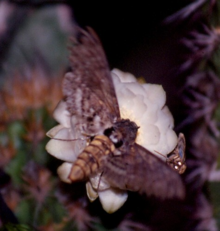| Giant sphinx | |
|---|---|

| |
| Scientific classification | |
| Domain: | Eukaryota |
| Kingdom: | Animalia |
| Phylum: | Arthropoda |
| Class: | Insecta |
| Order: | Lepidoptera |
| Family: | Sphingidae |
| Genus: | Cocytius |
| Species: | C. antaeus |
| Binomial name | |
| Cocytius antaeus (Drury, 1773) | |
| Synonyms | |
| |
Cocytius antaeus, the giant sphinx, is a moth of the family Sphingidae. The species was first described by Dru Drury in 1773.
Distribution
It is found from Brazil through Central America and into the southern parts of California, Texas, and Florida in the United States.
Description
The wingspan is 126–178 mm. Very rare in North America, it was once thought to be the only insect in the continent with a long enough proboscis to pollinate the ghost orchid.
Biology
The larvae feed on Annona glabra, Annona reticulata, Annona purpurea, Annona holosericea and Rollinia membranacea.
References
- "CATE Creating a Taxonomic eScience - Sphingidae". Cate-sphingidae.org. Archived from the original on 2012-08-02. Retrieved 2011-11-01.
- Giant Sphinx in CA
- "Silkmoths". Silkmoths.bizland.com. 2011-01-31. Archived from the original on 2016-03-04. Retrieved 2011-11-01.
External links
- Lotts, Kelly & Naberhaus, Thomas (2017). "Giant sphinx Cocytius antaeus (Drury, 1773)". Butterflies and Moths of North America. Retrieved January 1, 2019.
| Taxon identifiers | |
|---|---|
| Cocytius antaeus |
|
This Sphinginae-related article is a stub. You can help Misplaced Pages by expanding it. |



